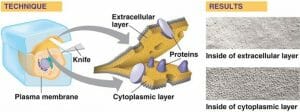Histology Definition
Histology is the study of the microscopic anatomy (microanatomy) of cells and tissues. Every cell of tissue type is unique, based on the many functions an organism carries out. Histology uses advanced imaging techniques to analyze and identify the tissues and structures present. Both light microscopy and specialized systems such as electron microscopy are used to visualize the tiny structures present in specially prepared tissue samples. The histology of different tissues can be used to identify unknown tissues, provide clues to the function of tissue or cells, or even identify disease in the cells of an organism.
Basic Procedures in Histology
Most scientists use the procedures developed by histology during the course of their studies. While histology is an enormously broad field, each researcher typically understands the basic histology of the organism they are working on. A botanist might not understand the human kidney, but plant tissues would be relatively familiar. The practices of histology have extended to nearly every field in science because of how useful they are in preparing and visualizing tissues.
Starting with simple observations using light microscopy, histology has evolved hundreds of different techniques and procedures for staining and observing cells. The most basic form, a simple stain, is achieved by allowing a specialized staining material to wash over cells on a slide. The stains are formulated so that they only stick to certain parts of a cell, such as the DNA. When the stain is washed away with water, only the DNA or other targeted material remains stained. This allows for better and more advanced viewing of different processes. It was in this way that the process of mitosis was first understood.
Another technique, sectioning, is used in many fields to identify the internal components of cells. Often used in conjunction with staining, this technique involves fixing a cell in a solid material so that sections of it can be cut off. At the simplest level, this can be done with an extremely sharp knife and an onion cell, but most applications require more precision. Methods have been invented of replacing the cytoplasm with plastic epoxy, then cutting through the hardened plastic. This method preserves the integrity of the internal components of the cell. Similarly, cells can be frozen and then fractured apart. This also reveals the internal components of the cell without damaging them.
These methods, in conjunction with new electron microscopy methods, have led to significant advances in histology and imaging in general. The above image shows the results of the freeze fracture technique employed with an electron microscope. These results helped show the complex arrangement of proteins which give structure to cell membranes. Scientists are now turning to histology to answer fundamental questions in many fields. For instance, the agricultural industry uses the histology of plants to identify early nutrient deprivations and water usage. The medical industry uses histology to diagnose and cure disease. Biologists use histology to combat pests and understand the interactions between organisms. These and more careers with histology are discussed below.
Careers in Histology
Histologists are scientists that specialize in the identification of various tissues and cells. Since the invention of the microscope, histology has been a field in science. The field has expanded rapidly, and the histology of most organisms is understood. Histology is used in a number of professional fields, from lab analyst to medical professional. Histologists are also used by law enforcement agencies to help solve crimes. A cytologist is a specialist focusing on the cells found in bodily fluids, which can often provide DNA evidence and more clues.
Histology degrees can be anything from histology certificate programs, training you to be a histology technician, to Master’s and Doctorate degrees in histology. Histology technicians usually work in a lab setting, processing samples from a hospital, clinic, or research center. Typically, technicians get to process samples and create slides and do the lab work involved in staining and visualizing structures. Identifying structures and diagnosing disease is taught in higher level programs, the highest being post-doctoral training and research in histology. These professionals work on the leading edge of the science and help create new and useful diagnoses and identification methods. A histologist at this level could start a lab, work for an established lab, or work for a research university teaching and researching.
Many medical technology companies, pharmaceutical companies, and other companies required to test their products need trained histologists. Much of the research done on products to understand their potential for doing harm is done on laboratory organisms. From bacteria to pigs, histologists who specialize in those tissues are needed to understand the complicated changes that some drugs and products may have on the tissues in the body. In understanding what to look for in normal tissue, a histologist can diagnose and theorize about why the product would create a specific reaction in tissue. This feedback is necessary for the biochemists and engineers to tweak their products to ensure they won’t be harmful to people.
As mentioned earlier in the article, many professionals simply need an understanding of histology to do their job. The variety of fields using histology is ever expanding. Histologists are needed to understand complex plant diseases, like the pine-beetle fungus that is currently infesting Rocky Mountain pines. Others are needed to understand domesticated plants and animals, and the many ailments and diseases that can affect them. Histology is a broad and complex field and offers a plethora of opportunity for the motivated student.
References
- Brusca, R. C., & Brusca, G. J. (2003). Invertebrates. Sunderland, MA: Sinauer Associates, Inc.
- McMahon, M. J., Kofranek, A. M., & Rubatzky, V. E. (2011). Plant Science: Growth, Development, and Utilization of Cultivated Plants (5th ed.). Boston: Prentince Hall.
- National Society for Histology. (2018, 1 22). Schools & Programs of Histotechnology. Retrieved from NSH.org: https://nsh.org/content/schools

